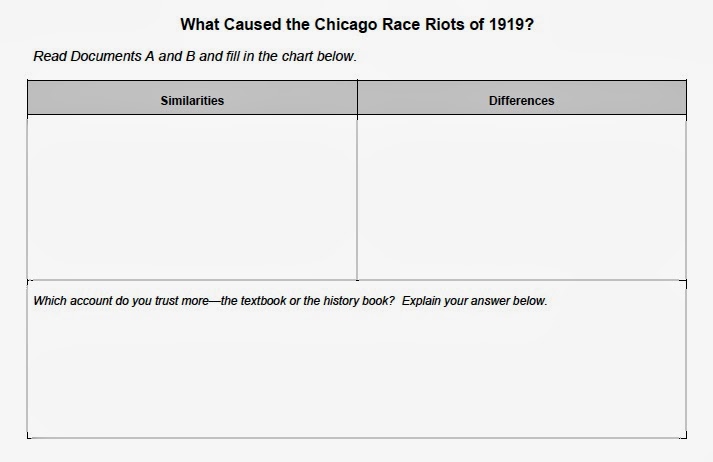Document A: Textbook
In the summer of 1919, over 20 race riots broke out across the
nation. The worst violence occurred in Chicago. On a hot July day,
African Americans went to a whites-only beach. Both sides began
throwing stones at each other. Whites also threw stones at an
African American teenager swimming near the beach to prevent him
from coming ashore, and he drowned. A full-scale riot then erupted
in the city. Angry African Americans attacked white neighborhoods
while whites attacked African American neighborhoods. The riots
lasted for several days. In the end, 38 people died—15 white and 23
black—and over 500 were injured.
Source: The American Vision, 2006, p. 393.
Document B: History Book
The most serious racial outbreak occurred in Chicago late in
July of the so-called Red Summer…. The riot that began on July 27
had its immediate origin in a fight at Lake Michigan beach. A young
Negro swimming offshore had drifted into water that was customarily
used by whites. White swimmers commanded him to return to his
part of the beach, and some threw stones at him. When the young
man drowned, the Negroes declared that he had been murdered....
Rumors spread among blacks and whites. Mobs sprang up in
various parts of the city. In the next afternoon, white bystanders
bothered some blacks who were returning from work. Some were
pulled off streetcars and whipped.... On the Negro South Side a
group of young Negroes stabbed an old Italian peddler to death, and
a white laundry operator was also stabbed to death.... When
authorities counted the casualties, 38 people had been killed,
including 15 whites and 23 blacks. Of the 537 people injured, 342
were black. More than 1,000 families, mostly Negroes, were
homeless due to the burnings and destruction of property.
Source: John Hope Franklin, From Slavery to Freedom: A History of Negro
Americans, 1987 (Sixth Edition; first published in 1947). Franklin was a United
States historian and past president of the Organization of American Historians
and the American Historical Association. More than three million copies of From
Freedom to Slavery have been sold. In 1995, Franklin was awarded the
Presidential Medal of Freedom, the nation's highest civilian honor.
Document C (Modified)
Since 1915 the colored population of Chicago has more than
doubled, increasing in four years from a little over 50,000 to what is
now estimated to be between 125,000 and 150,000. Most blacks
lived in the area called the “Black Belt.” Already overcrowded, this socalled
“Black Belt” could not possibly hold the doubled colored
population. One cannot put ten gallons of water in a five-gallon pail.
Whites who are afraid that blacks will move out of the “Black
Belt” and into “white” neighborhoods have formed the “Property
Owners' Association” to keep blacks out of white neighborhoods.
They discuss ways to keep Negroes in “their part of town.”
In a number of cases during the period from January 1918 to
August 1919, there were bombings of colored homes and houses
occupied by Negroes outside of the “Black Belt.” During this period no
less than twenty bombings took place, yet only two persons have
been arrested and neither of the two has been convicted.
Source: The document above was published in an African-American
newspaper in 1919. Its author was a leader of the NAACP, an
organization devoted to protecting African American rights.
Document D (Modified)
The spirit of the Negro who went across the seas -- who was in battle
-- is different from the spirit of the Negro before the war. He is
altogether a new man, with new ideas, new hopes, new dreams, and
new desires. He will not quietly accept discrimination, and we should
not ask him to do so. It is a new Negro that we have with us now. . . .
The war transformed these men into new creatures -- citizens of
another type.
Source: The article above was published on August 16, 1919 in The
Independent, a New York magazine. The author is writing about black soldiers
who served in World War One in Europe. More than 350,000 African Americans
served in World War One, which ended in 1919. W.S. Scarborough (1852-1926),
was an African American author, educator, and lecturer. He was born a slave
but eventually became a professor of Latin and Greek, and later president, at
Wilberforce University. He wrote frequently about civil rights issues.
Document E (Modified)
Many people in Chicago worked at meat-packing factories, where they
prepared meat to be shipped around the country. These factories were
also called “stockyards.”
Packers’ Force Cut by 15,000
Chicago Daily Tribune, April 12, 1919
Outsiders who are thinking of coming to Chicago to take a “job
at the yards” will not find the “welcome” sign out awaiting them.
It became known yesterday that since the end of the Great War
the force of workers has dropped by nearly 15,000. This is due both
to a big drop in war orders. . . .
Another problem is that the factories promised to return every
employee who enlisted in the armed forces to “as good or better” a
job than he held when he put on a uniform. [White] men are now
returning in increasingly large numbers and none are being turned
away.
“No discrimination is being shown in the reducing of our forces,”
said an official of one of the packing companies, in discussing reports
that southern colored men, who were hired during the war job
shortage, were being fired. “It is a case of survival of the fittest, the
best man staying on the job. It is a fact that the southern Negro
cannot compete with the northerner.”
Source: The article above is from the Chicago Tribune, the main
newspaper in Chicago, April 12, 1919.


No comments:
Post a Comment